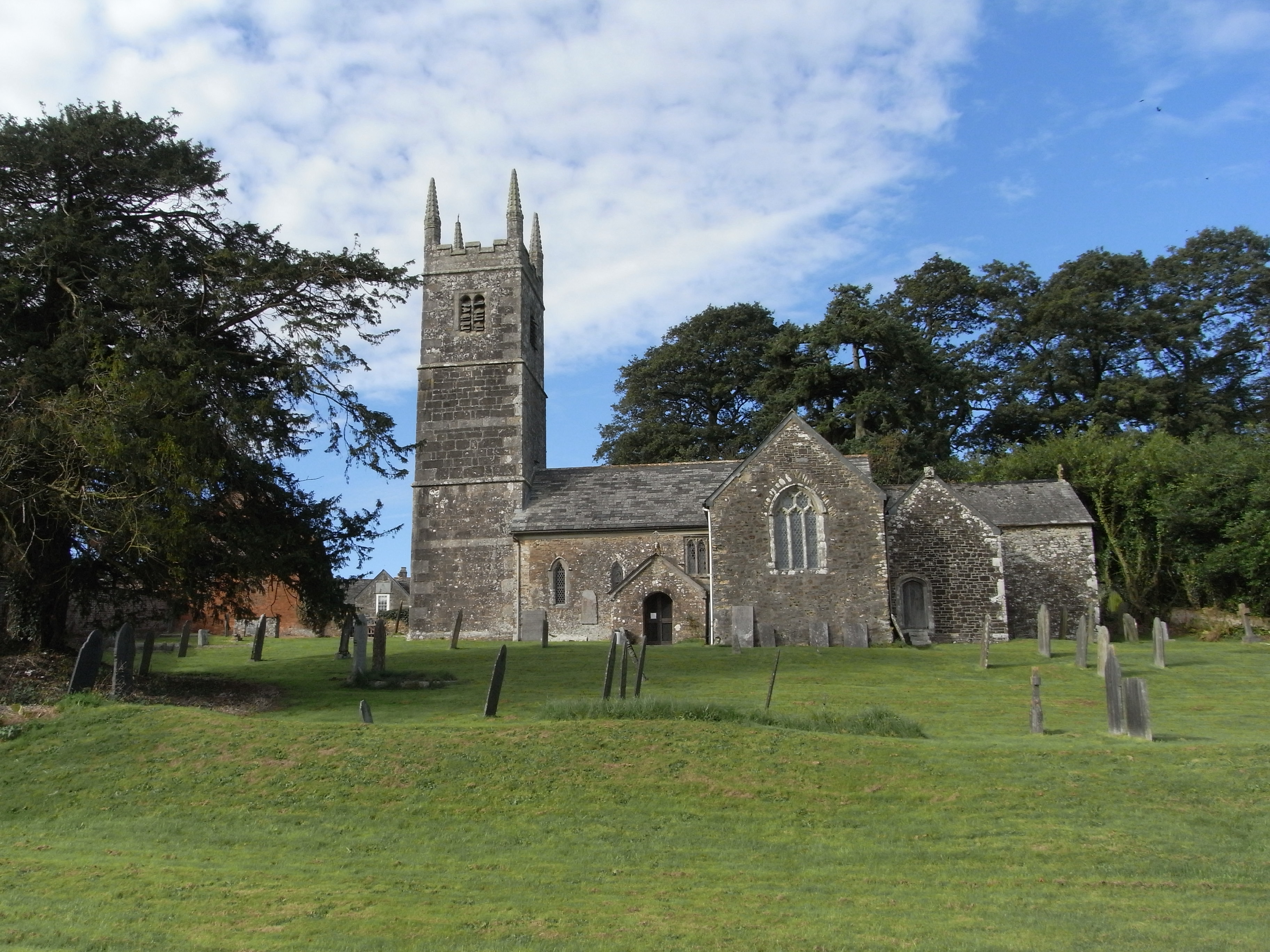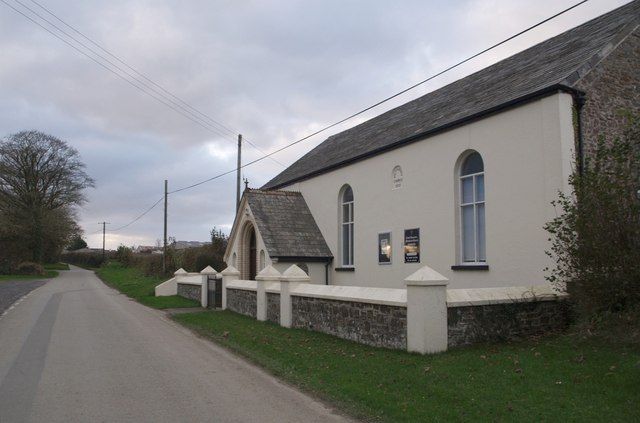|
Tetcott
Tetcott is a civil parish, small settlement and former manor (once the home of the Arscotts of Tetcott) in Devon, England. The parish lies about five miles south of the town of Holsworthy and is bordered on the north by the parish of Clawton, on the east by a small part of Ashwater, and on the south by Luffincott. It forms part of the local government district of Torridge, and its western boundary is the River Tamar which forms the Cornish border. In 2001 its population was 110, half that of a century earlier (220 in 1901). The settlement of Tetcott itself consists almost solely of the manor house and parish church of Holy Cross, but there are other hamlets in the parish, the largest of which is Lana about half a mile to the south-east. Parish church The parish church was dedicated by the Bishop of Waterford in 1338 or 1339. Before the Reformation it was dedicated to the Trinity. In 1740 the parish feast day was said to have been 3 May (the date of the Invention of the Tru ... [...More Info...] [...Related Items...] OR: [Wikipedia] [Google] [Baidu] |
John Arscott (1613–1675)
John Arscott (1613-1675), of Tetcott, Devon, was Sheriff of Devon in 1675. W. G. Hoskins described the Arscotts as one of the ancient families of freeholders that rose to the ranks of the squirearchy over a period of 300 years or so by the steady accumulation of property, mostly through marriage. Originating at Arscott (now known as South Arscott, north of the town of Holsworthy) in the time of Henry III,, a junior branch of the family moved to Tetcott in about 1550. John Arscott was the eldest son and heir of Edmund Arscott (1588–1656), of Tetcott, by his wife Mary Walrond (died 1652), daughter of William Walrond (died 1627) of Bradfield, Uffculme. Arthur Arscott (1554–1618), the sheriff's grandfatherVivian, p.21 built a new manor house at Tetcott in 1603. He married Gertrude Calmady (1622–1699), a daughter of Sir Shilston Calmady (1585–1645) of Langdon, Wembury, who was killed during the Civil War during the siege of Ford Abbey. In 1638 John's sister Mary Arscott h ... [...More Info...] [...Related Items...] OR: [Wikipedia] [Google] [Baidu] |
Luffincott
Luffincott is a civil parish in the far west of Devon, England. It forms part of the local government district of Torridge and lies about six miles south of the town of Holsworthy. The parish is surrounded clockwise from the north by the parishes of Tetcott, Ashwater, St Giles on the Heath and Northcott. Its western border follows the River Tamar which forms the county boundary with Cornwall. The A388 road between Holsworthy and Launceston runs just inside the eastern border of the parish. In 2001 its population was 45, down from 62 in 1901 and for ecclesiastical purposes, it is united with Tetcott. The name ''Luffincott'' has a variety of early forms, first appearing in documents as ''Leghygnecoth′'' in 1242 with variants such as ''Loghingecote'' (1285), ''Lughyngcote'' (1330), ''Loghynton que vocatur Loghyngecote'' (1346) and ''Luffencote'' (1577). Its derivation is ''cot'' (cottage or small settlement) of ''Luhha''′s people. The manor is believed to have been the orig ... [...More Info...] [...Related Items...] OR: [Wikipedia] [Google] [Baidu] |
North Tamerton
North Tamerton ( kw, Tre war Damer) is a village and civil parishes in England, civil parish in east Cornwall, England, UK. The village is situated approximately eight miles (13 km) southeast of Bude and eight miles (13 km) north of Launceston, Cornwall, Launceston.Ordnance Survey: Landranger map sheet 190 ''Bude & Clovelly'' Geography North Tamerton is a thinly populated rural parish and the only village is North Tamerton itself, the other settlements being farmsteads and hamlets. It came within the Hundreds of Cornwall, hundred, and later the registration district, of Stratton, Cornwall, Stratton. It is bounded to the east by the River Tamar which for much of its length delineates Cornwall's border with Devon, but here Cornwall extends across the river making North Tamerton the only parish in Cornwall which includes land east of the Tamar. [...More Info...] [...Related Items...] OR: [Wikipedia] [Google] [Baidu] |
Clawton
Clawton is a village and civil parish in the far west of Devon, England. It forms part of the local government district of Torridge. The village lies about three miles south of the town of Holsworthy on the A388 road. The parish is surrounded clockwise from the north-west by the parishes of Pyworthy, Holsworthy Hamlets, Ashwater, and Tetcott. Its western border follows the River Tamar which forms the county boundary with Cornwall. In 2001 its population was 326, slightly down from 389 in 1901. The ancient parish church, dedicated to St Leonard, has some Norman features in one of its windows and it has a Norman font. Its tower and the arcades of the north and south aisles date from the 14th century and it has 15th-century arches of Polyphant stone. It was partly restored in 1873. Blagdon a former manor house, is situated nearby. Other notable buildings in the parish are ; Gunnacott, which Pevsner Pevsner or Pevzner is a Jewish surname. Notable people with the surname include: * ... [...More Info...] [...Related Items...] OR: [Wikipedia] [Google] [Baidu] |
Sheriff Of Devon
The High Sheriff of Devon is the Queen's representative for the County of Devon, a territory known as his/her bailiwick. Selected from three nominated people, they hold the office for one year. They have judicial, ceremonial and administrative functions and execute High Court Writs. The title was historically "Sheriff of Devon", but changed in 1974 to "High Sheriff of Devon". History The office of Sheriff is the oldest under the Crown. It is over 1000 years old; it was established before the Norman Conquest. It remained first in precedence in the counties, until the reign of Edward VII, when an Order in Council in 1908 gave the Lord-Lieutenant the prime office under the Crown as the Sovereign's personal representative. Under the provisions of the Local Government Act 1972, on 1 April 1974 the office previously known as Sheriff was retitled High Sheriff. The High Sheriff remains the Sovereign's representative in the county for all matters relating to the Judiciary and the mainten ... [...More Info...] [...Related Items...] OR: [Wikipedia] [Google] [Baidu] |
Feast Of The Cross
In the Christian liturgical calendar, there are several different Feasts of the Cross, all of which commemorate the cross used in the crucifixion of Jesus. Unlike Good Friday, which is dedicated to the passion of Christ and the crucifixion, these feast days celebrate the cross itself, as the sign of salvation. In Western Catholicism, Eastern Catholicism, Eastern Orthodoxy, Oriental Orthodoxy, Lutheranism and Anglicanism the most common day of commemoration is 14 September, or 27 September in churches still using the Julian calendar. In English, the feast is called The Exaltation of the Holy Cross in the official translation of the Roman Missal, while the 1973 translation called it The Triumph of the Cross. In some parts of the Anglican Communion the feast is called Holy Cross Day, a name also used by Lutherans. The celebration is also sometimes called Holy Rood Day. History The Feast of the Exaltation of the Holy Cross, celebrated every year on 14 September, recalls three ev ... [...More Info...] [...Related Items...] OR: [Wikipedia] [Google] [Baidu] |
William George Hoskins
William George Hoskins (22 May 1908 – 11 January 1992) was an English local historian who founded the first university department of English Local History. His great contribution to the study of history was in the field of landscape history. Hoskins demonstrated the profound impact of human activity on the evolution of the English landscape in a pioneering book: ''The Making of the English Landscape''. His work has had lasting influence in the fields of local and landscape history and historical and environmental conservation. Life William George Hoskins was born at 26–28 St David's Hill, Exeter, Devon on 22 May 1908: his father, like his grandfather, was a baker. He won a scholarship to Hele's School in 1918, and attended the University College of South West England where he gained BSc and MSc degrees in economics by the age of 21. Both his MSc in 1929 and his PhD in 1938 were on the history of Devon. The remainder of his life was devoted to university teaching and the ... [...More Info...] [...Related Items...] OR: [Wikipedia] [Google] [Baidu] |
Transept
A transept (with two semitransepts) is a transverse part of any building, which lies across the main body of the building. In cruciform churches, a transept is an area set crosswise to the nave in a cruciform ("cross-shaped") building within the Romanesque and Gothic Christian church architectural traditions. Each half of a transept is known as a semitransept. Description The transept of a church separates the nave from the sanctuary, apse, choir, chevet, presbytery, or chancel. The transepts cross the nave at the crossing, which belongs equally to the main nave axis and to the transept. Upon its four piers, the crossing may support a spire (e.g., Salisbury Cathedral), a central tower (e.g., Gloucester Cathedral) or a crossing dome (e.g., St Paul's Cathedral). Since the altar is usually located at the east end of a church, a transept extends to the north and south. The north and south end walls often hold decorated windows of stained glass, such as rose windows, in sto ... [...More Info...] [...Related Items...] OR: [Wikipedia] [Google] [Baidu] |
Ring Of Bells
A "ring of bells" is the name bell ringers give to a set of bell (instrument), bells hung for English full circle ringing. The term "peal of bells" is often used, though peal also refers to a change ringing performance of more than about 5,000 Method ringing, changes. By ringing a bell in a full circle, it was found in the early 17th century that the speed of the bell could be easily altered and the interval between successive soundings (strikes) of the bell could be accurately controlled. A set of bells rung in this manner can be made to strike in different sequences. This ability to control the speed of bells soon led to the development of change ringing where the striking sequence of the bells is changed to give variety and musicality to the sound. The vast majority of "rings" are in bell tower, church towers in the Anglican church in England and can be three to sixteen bells, though six and eight bell towers are the most common. They are musical tuning, tuned to the notes ... [...More Info...] [...Related Items...] OR: [Wikipedia] [Google] [Baidu] |






